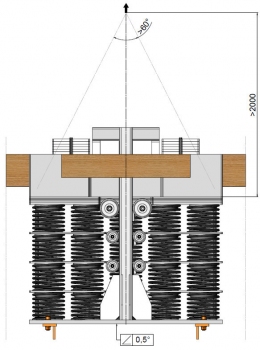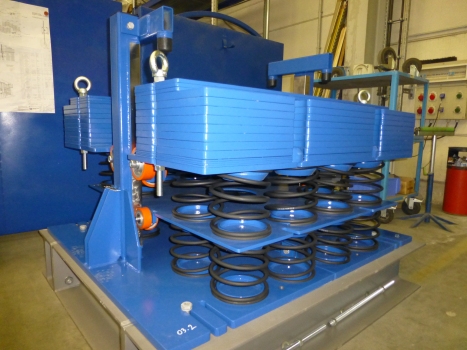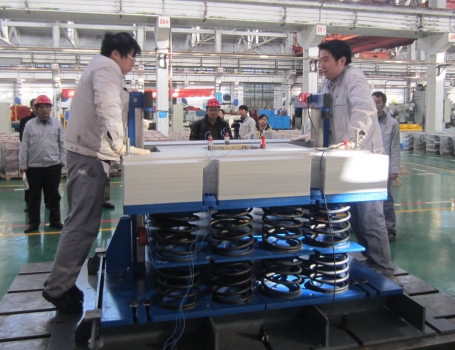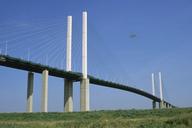Hong Kong-Zhuhai-Macao Bridge resists laminar flows with Tuned Mass Dampers
Presently, and starting from Hong Kong, the 35 km long Hong Kong-Zhuhai-Macao Bridge is being constructed over the delta of the Pearl River. The bridge steel decks are exposed to laminar flows caused by wind, which may trigger the natural frequency of the bridge and consequently can lead to dangerous vibrations. To damp these vibrations, MAURER developed a TMD (Tuned Mass Dampers) system which is permanently fatigue-proof as well as wear-free. This system will be adapted on site to the real occurring natural frequencies. A particular challenge was in the low frequencies of up to 0.33 Hz, the frictionless vertical guidance of big masses of up to 6,250 kg, and the limited available space inside of the bridge deck.
Media
These days, the Hong Kong-Zhuhai-Macao Bridge (HZMB) is being erected as road link with each three lanes per direction between Hong Kong, Zhuhai, and Macao. The foundation stone ceremony was in 2009, and the inauguration is planned for 2017.
Laminar flows in exposed position
Because of its exposed position, the bridge has to be damped. More or less laminar wind flows blow over the Pearl River delta. By way of a pulsating breaking off of this flow, grave vertical vibrations of the carriageway may be caused. Because some of the bridge decks only possess little own damping, these bridge decks need to be damped.
Three challenges
The designers decided to employ passive TMDs. They have to comply with three criteria:
- reduce vertical vibrations,
- damp the structure and thus "ease it off" and
- fit into the limited space of the steel bridge deck.
A special challenge was to develop a TMD system which on the one hand can respond to the low natural frequency of 0.33 Hz, and on the other hand let the masses of the TMD oscillate by as much as +/- 350 mm. In this respect, MAURER could make use from their experience of the Wolgograd project. That steel bridge structure, also known as "dancing bridge", had to be damped after inauguration of the bridge, and this under extremely tight space constraints.
In total the dampers ease the motions of the bridge deck, thus preventing fatigue effects and increasing the service life of the bridge. In respect to the total costs of the bridge, employing TMDs are more economical than the alternative, which is stiffening the structure.
Tailor made development
For various sections of the Deep Water Viaduct and Jianghai Bridge, MAURER designed a total of 96 TMDs, tailor made for their respective sections. The frequencies are in a range between 0.33 and 0.806 Hz, the masses between 3,000 and 6,250 kg, oscillating with amplitudes of 280 to 350 mm.
All TMDs had to be designed in a way that they could fit into a space of 1.5 x 2 x 3.5 m. Moreover, some TMDs had to be designed in parts, such that they could fit through the maintenance openings of the completed bridge decks, and assembled on site.
Jianghai Bridge
A highlight is the Jianghai Bridge, a cable stayed bridge with two main spans of 258 m. This bridge posed the biggest challenge, because there the biggest TMDs (6,250 kg) with the lowest frequency (0.332 Hz) had to be positioned, thus the TMDs with the softest and the biggest spring system. Furthermore, two modes had to be damped, which resulted in two TMDs per each mode, at a location where their amplitude is biggest.
The sections of the Deep Water Viaduct are 660, 550 or 440 m long and supported each 110 m. The dampers were installed in the centre of these sections, which is the location of the maximum oscillation of the bridge deck.
Design of the TMD components
Principally, the TMDs consist of mass, springs, guide system, rotation damper and base plate. Special feature is that the mass does not hang on tension spring, but stands on several compression springs. This design principle reduces remarkably the height of the mass-spring unit, such that now also the biggest TMD systems fit into the limited space of Jianghai Bridge. Moreover, hanging springs would have the disadvantage that during their oscillation they are exposed to alternate stresses which would create fatigue effects and thus reduce the lifetime of the springs.
Fatigue-proof spring system
The coil springs consist of 54SiCr6 (EN10089). This material is extremely elastic and fatigue resistant. It is equipped with a special corrosion protection system. The springs were intensively tested, and after testing displayed only extremely small deviations. That is, the spring parameters remained unchanged. Consequently, the springs can be considered as practically fatigue-proof.
In order to prevent torsion effects when the masses move up and down, one half of the springs display of a right winding, the other half of a left winding.
Vertical Mass Guide System
For a perfectly vertical TMD mass movement, a frictionless guide system for all TMDs was developed. The lowest natural frequency of the Jianghai Bridge (0.33 Hz) required for the unstressed springs an initial height of around 4 m. Under the weight of the mass this springs are compressed to 960 mm height – an enormous challenge. Therefore each spring was separated into four units which stand on top of each other. Between the units, cross plates were inserted which are guided laterally along vertically arranged rails of rustproof steel on PE rolls with highly precise ball bearings. This minimizes the friction and stabilizes the springs against buckling.
Fine tuning of the TMDs
In spite of numerically highly precise vibration calculations, the actually measured natural frequency of the bridge can deviate from the calculations. Thus, the natural frequency of the TMDs can be adapted (tuned) on site with two methods:
- Additional tuning springs allow for an adaptation of +/- 12 %.
- The damper mass can be reduced or increased by as much as 6 %, which corresponds to an adaptation of the frequency by as much as +/- 3 %.
Rotation damper unit
Damping respectively reduction of the amplitude of the mass to a maximum of +/- 350 mm is achieved by way of special rotation dampers. They consist mainly of a disc which rotates in hydraulic oil. The damping effects are achieved by way of shear forces between rotating disc, oil, and housing. The rotation is achieved by way of a cog wheel which is connected via a vertical tooth bar to the TMD mass. The damper units were tested for temperatures at -10°, 20° and 60° C. No noteworthy variations in performance could be observed.
Tests of the fully assembled TMD
An original TMD as it will be employed later at the Deep Water Viaduct was successfully tested in the test laboratory in Wuhan. The TMD showed exactly the requested performance with respect to frequency (+/-1 %) and damping (+/-10 %).
For cost reasons, the steel plates acting as masses for the TMDs were produced in China. In May 2016 almost all TMDs were installed. Tuning is expected to be carried out in the autumn of 2016.
References
Structure Types
- About this
data sheet - Product-ID
7391 - Published on:
07/07/2016 - Last updated on:
17/11/2021





 MAURER SE
MAURER SE 



